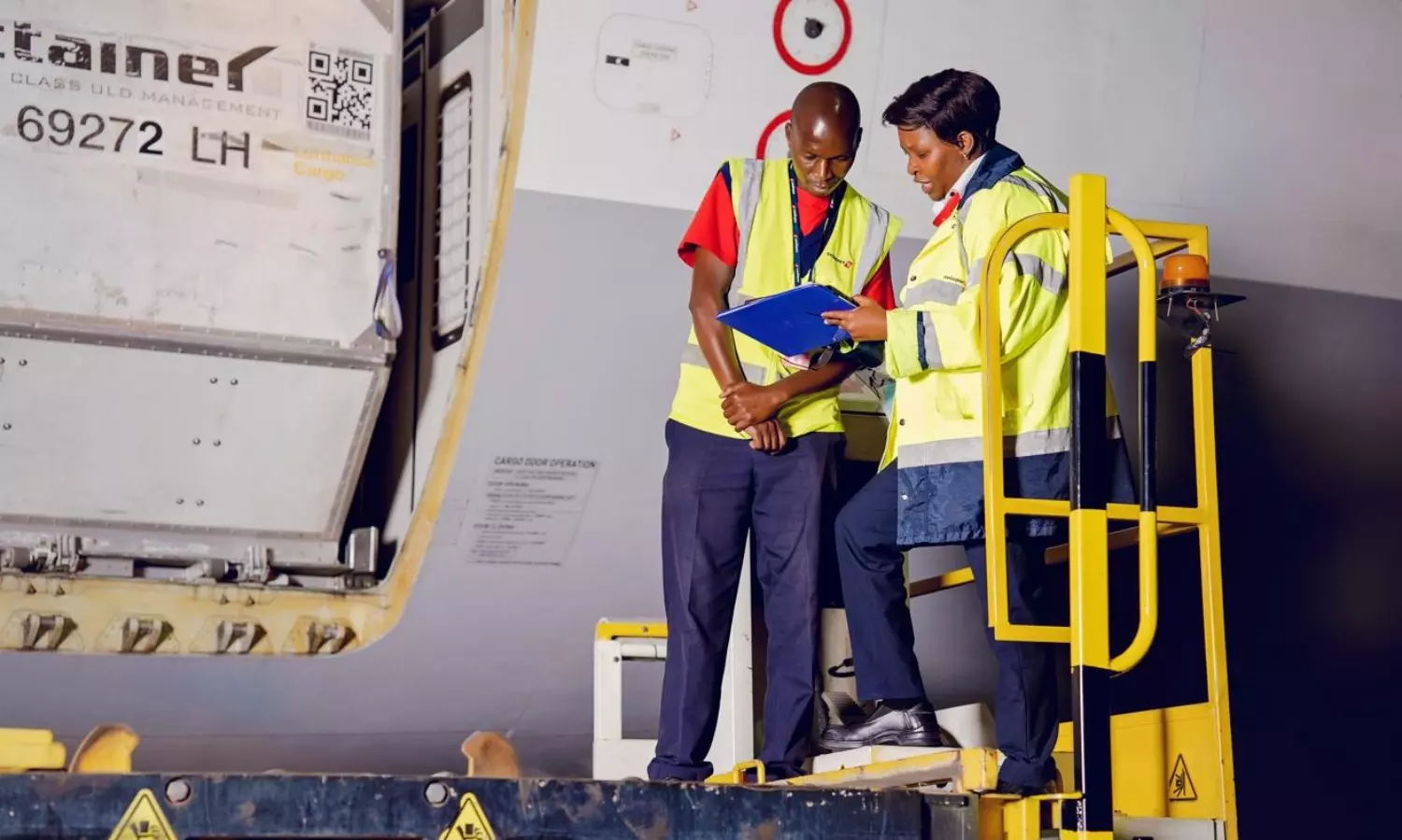African nations turning serious about its cargo airports
The African nations are getting serious about their airports and particularly cargo operations at airports. This is visible in the efforts of government-controlled airport authorities as well as the funding they are accepting from foreign investors.

Photo credit: Swissport Kenya
On August 22, 2023, Vice-President of Ghana Mahamudu Bawumia commissioned the Tamale International Airport Phase II Project in the Northern Regional capital.
The Ghanaian government, along with Bawumia, hopes that the completion of this ultra-modern terminal building together with a multi-purpose terminal and other ancillary facilities provide the needed impetus for increased economic trading activities and to reinforce the status of Tamale as a Sub-Saharan hub airport for flights to and from neighbouring West African countries and the Sahel Region.
The Northern Region is renowned for its vibrancy in agricultural and economic activities. The location of the airport within the Sahelian belt, also referred to as the food basket of Ghana, is expected to enhance access to the market for local agricultural produce, enhance tourism and attract passengers from neighbouring countries.
As the vice president puts it, “Indeed, the government intends to use Tamale International Airport to support the programmes of the Northern Development Authority (NDA) of Ghana to harness fresh agricultural produce for export to other parts of the world and to generate employment and create wealth in this geographical zone. The boost in agriculture would be leveraged to support the development of Agro-based industries in Northern Ghana. The expansion of the Tamale International Airport is expected to serve as a catalyst for industrialization and rapid socio-economic development. It is my hope that other service providers will leverage the completion of this project to invest in other areas such as the establishment of Maintenance, Repair and Overhaul (MRO) facility, development of cargo facilities and cold stores for the export of fresh produce and establishment of Aviation Training Organization (ATO) among others.”
“Africa as a continent faces limitations in terms of airport infrastructure, system and policy compared to other developing continents.”
Abel Alemu, Ethiopian Cargo & Logistics Services
Tamale International Airport is one example among many in Africa where the government and local authorities hope to initiate industrialisation, tap social economic growth and attract investments around an airport and particularly their cargo operations.
It should be noted that Africa’s share in the global air cargo market is a mere 2 percent compared to Asia Pacific’s 32, North America’s 28 and Europe’s 21. However, as an untapped market the long-term potential for growth in this market is also huge.
For example, according to the July 2023 cargo traffic numbers of the International Air Transport Association (IATA), African airlines had the strongest performance with a 3 percent increase in cargo volumes compared to July 2022. Notably, Africa–Asia routes experienced significant cargo demand growth (10 percent).
While agreeing that Africa’s share in the market is too low, Bonface Muse, senior commercial officer, cargo, Kenya Airports Authority, also points out an important metric which is the intra-Africa trade and air cargo movements.
As he said, “Air cargo in Africa is still less developed. We are way behind the global market. Especially, we have very little intra-Africa trade. Even at our leading airport Jomo Kenyatta International Airport in Nairobi, the business is mostly outbound to Europe, Asia and the Middle East and intra-Africa is a small percentage. The outbound is mostly fresh produce like flowers, fruits, vegetables, meat and fish.”
Jomo Kenyatta International Airport is among the best cargo airports in Africa and it competes with Ethiopia’s Addis Ababa, South Africa’s Johannesburg in the south and Morocco in the north.
Meanwhile, Abel Alemu, MD, Ethiopian Cargo & Logistics Services, pointed out that governments in the continent must invest so that infrastructure and enabling policies are introduced in African airports.
“African airports serve as important transportation hubs that link countries in the continent to one another and to the rest of the world. African airports are key for facilitating trade, and tourism, boosting economic development and linking people between Africa and the rest of the globe. Africa as a continent faces limitations in terms of airport infrastructure, system and policy compared to other developing continents. The air connectivity between airports is also lower thus creating a gap in what the continent could have achieved,” he said.
“We want to ensure that the aeroplanes, once they drop the electronics and dry goods at Eldoret Airport from Asia and the Middle East , are able to take off with flowers, vegetables and fruits."
Bonface Muse, Kenya Airports Authority
Despite these challenges, the air cargo experts and professionals see many positive developments in the African continent. For instance, Muse took the example of how Rwanda is building a new airport in partnership with Qatar Airways.
In fact, the country of Rwanda is building a new $2 billion airport in the Bugesera District just 40 kilometres away from the capital city of Kigali called Bugesera International Airport. Qatar Airways will have 60 percent ownership of the new airport and it will also acquire 49 percent of shares in the country’s airline Rwandair. Also in May 2023, Qatar Airways Cargo launched its first hub outside Qatar and began operations at its new hub in Kigali.
Other developments pointed out by Muse include the African Continental Free Trade Area Agreement (AfCFTA) and the Single African Air Transport Market (SAATM).
“AfCFTA is an initiative by the African Union and it is about opening up borders. We want to make Africa operate like the European Union, where there is a borderless movement and less restriction between countries for free trade. SAATM is about opening up the skies. We want the freedom of skies which means we can move freely within the African continent without those restrictions,” he said.
“For example,” he added, “I should be able to fly goods from Europe directly to Nigeria without making a stopover in Nairobi.”
Meanwhile, Alemu spoke about the developments at the Ethiopian Airlines front. Ethiopian Airlines is Africa's largest airline, providing both passenger and cargo services. One of its strategic eight business units, Ethiopian Cargo and Logistics Services covers more than 130 international destinations around the world with both belly hold capacity and 67 dedicated freighter services.
“We have invested more in fleet, infrastructure, systems and human capital to meet the continent's passenger and cargo demand while also connecting Africa to the rest of the world. We operate a state-of-the-art cargo facility with a capacity to handle one million tonnes of cargo annually and we serve more than 130 destinations in Africa, the Middle East, Europe, Asia and the Americas with a fleet of more than 140 modern and young aircraft,” he said.
One step ahead, Alemu also reported that Ethiopian Airlines is finalising all preparations to provide end-to-end e-commerce logistics services across its selected wide network.
“We are utilising the most advanced e-commerce handling system for consolidation, deconsolidation, sortation, repacking, labelling, and other services in our e-commerce dedicated warehouse, which has a capacity of 150,000 tonnes annually. We have positioned ourselves to provide door-to-door services with our partners as demanded,” he added.
As Muse spoke about the infrastructure in Kenya, he noted that the country has one of the best and most modern air cargo facilities in the region and for example, Jomo Kenyatta International Airport is only utilising 40 percent of its air cargo handling capacity. So you can see the potential with the 60 percent underutilised capacity.
“Our main role is to facilitate and fulfil needs for putting up air cargo facilities. It is not the authority that does that. We will facilitate private cargo handlers by providing them with the land,” he said.
It is not just Kenya, Ethiopia, Ghana or Rwanda, but other African countries also understand the importance of cargo facilities. For instance, at the constrained cargo terminal at OR Tambo International Airport (ORTIA) in Johannesburg, Airports Company of South Africa (ACSA) announced that it intends to conclude an expansion of the cargo terminal in the next five years.
Even though Jomo Kenyatta International Airport is the biggest airport handled by Kenya Airports Authority, there are other important cargo airports that could witness potential growth in the near future. This includes Eldoret International Airport, located in the north rift of the country, Moi International Airport, close to Mombasa Port and Kisumu International Airport.
For instance, Eldoret Airport is a prime example of how African airports are transforming and the potential they hold. Eldoret currently only imports, mostly from the Middle East and the Far East. Even though Eldoret is an agricultural city, Kenya is not doing any exports from the airport because the runway is short and is located in a high-altitude area. This means a big aircraft cannot take off with maximum weight from Eldoret International Airport. Emirates, Ethiopian and Astral Aviation already operate to Eldoret but leave almost empty.
However, Kenya Airports Authority and Muse are determined to change this. Muse said, “We are expanding the runway and building modern cold room warehouses under public-private partnerships. We want to ensure that the aeroplanes, once they drop the electronics and dry goods from Asia and the Middle East, are able to take off with flowers, vegetables and fruits directly to European, Asian and Middle Eastern markets.”
The Authority is also putting up modern warehouses in Moi International Airport to support marine exports to Asia, the Middle East and Europe as it is close to the coastal region while Kisumu International Airport will be able to handle the fish from one of the biggest freshwater lakes in the world, Lake Victoria.
This feature was originally published in the Sept - Oct 2023 issue of Logistics Update Africa


